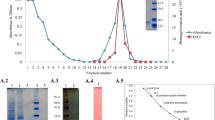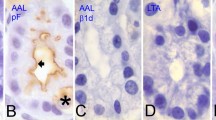Abstract
• Background: This study was carried out in order to obtain information on galactose-containing glycoconjugates in the lens and ciliary body of human eyes with capsular glaucoma and thus on the etiopathogenesis of exfoliation syndrome. • Methods: Six formalin-fixed, paraffin-embedded human eyes with capsular glaucoma and six control eyes were studied using a panel of 11 biotinylated lectins with extended binding sites to galactose- and N-acetylgalactosamine-containing glycoconjugates. Both pepsin and neuraminidase pretreatments were performed. • Results: Gal(ß1→3)Ga1NAc-reactive peanut (PNA) and Bauhinia purpurea alba (BPA) agglutinins and Gal(ß→4)G1cNAc G1cNAc-reactive Ricinus communis (RCA-1) and Phaseolus vulgaris (PHA-E) agglutinins reacted strongly with exfoliation material, while binding of Gal(ß → 4)G1cNAc-reactive Erythrina cristagalli and GaINAc-reactive soybean, Caragana arborescens, Vicia villosa, Helix pomatia (HPA) and Dolichos biorus agglutinins was generally weak. In the nonpigmented ciliary epithelium and on the zonular fibers and lamella, at least moderate reaction was detected with PNA, BPA, RCA-1 and PHA-E, and these tissues thus resembled exfoliation material in their reactivity. In contrast, the lens epithelium reacted weakly with PHA-E and HPA only, and the lens capsule was never labeled. No qualitative changes were seen after neuraminidase pretreatment. • Conclusion: The findings suggest that galactose- and N-acetylgalactosamine-containing glycoconjugates in exfoliation material are at least partially produced by the nonpigmented ciliary epithelium, rather than by the lens epithelium. Moreover, PNA, BPA, RCA-1 and PHA-E seem to be the most suitable of the lectins tested for detection of exfoliation material in histological specimens.
Similar content being viewed by others
References
Bartholomew RS (1970) Lens displacement associated with pseudocapsular exfoliation. Br J Ophthalmol 54:744–750
Bertelsen TI, Ehlers N (1969) Morphological and histochemical studies on fibrillopathia epitheliocapsularis. Acta Ophthalmol (Copenh) 47:476–488
Bertelsen TI, Drablös PA, Flood PR (1964) The so-called senile exfoliation (pseudoexfoliation) of the anterior lens capsule, a product of the lens epithelium. Fibrillopathia epitheliocapsularis. A microscopic, histochemic and electron microscopic investigation. Acta Ophthalmol (Copenh) 42:1096–1113
Cummings RD, Kornfeld S (1982) Characterization of structural the determinants required for the high affinity interaction of asparagine-linked oligosaccharides with immobilized Phaseolus vulgaris leukoagglutinating and erythroagglutinating lectins. J Biol Chem 257:11230–11234
Damjanov I (1987) Biology of disease. Lectin cytochemistry and histochemistry. Lab Invest 57:5–20
Dark AJ, Streeten BW, Cornwall CC (1977) Pseudoexfoliative disease of the lens: a study in electron microscopy and histochemistry. Br J Ophthalmol 61:462–472
Eagle RC, Font RL, Fine BS (1979) The basement membrane exfoliation syndrome. Arch Ophthalmol 97:510–515
Goldstein IJ, Poretz RD (1986) Isolation, physiocochemical characterization, and carbohydrate-binding specificity of lectins. In: Liener IE, Sharon N, Goldstein IJ (eds) The lectins: properties, functions, and applications in biology and medicine. Academic Press, New York, pp 33–247
Goldstein IJ, Hughes RC, Monsigny M, Osawa T, Sharon N (1980) What should be called a lectin? Nature 285:66
Hietanen J, Tarkkanen A (1989) Glycoconjugates in exfoliation syndrome. A lectin histochemical study of the ciliary body and lens. Acta Ophthalmol (Copenh) 67:288–294
Hsu S-M, Raine L (1982) Versatility of biotin-labeled lectins and avidin-biotin-peroxidase complex for localization of carbohydrate in tissue sections. J Histochem Cytochem 30:157–161
Jerndal T (1985) The initial stage of the exfoliation syndrome. Acta Ophthalmol (Copenh) [Suppl] 173:65–66
Kivelä T (1990) Characterization of galactose-containing glycoconjugates in the human retina: a lectin histochemical study. Curr Eye Res 9:1195–1209
Kivelä T, Tarkkanen A (1987) A lectin cytochemical study of glycoconjugates in the human retina. Cell Tissue Res 249:277–288
Kornfeld R, Kornfeld S (1970) The structure of a phytohemagglutinin receptor site from human erythrocytes. J Biol Chem 245:2536–2545
Leathern A, Atkins N (1983) Lectin binding to formalin-fixed paraffin sections. J Clin Pathol 36:747–750
Lis H, Sharon N (1986) Lectins as molecules and as tools. Ann Rev Biochem 55:35–67
Lotan R, Skutelsky E, Danon D, Sharon N (1975) The purification, composition, and specificity of the anti-T ectin from peanut (Arachis hypogaea). J Biol Chem 250:8518–8523
Morrison JC, Green WR (1988) Light microscopy of the exfoliation syndrome. Acta Ophthalmol (Copenh) [Suppl] 184:5–27
Ringvold A (1988) Exfoliation syndrome. Immunological aspects. Acta Ophthalmol (Copenh) [Suppl] 184:35–43
Sarkar M, Wu AM, Kabat EA (1981) Immunochemical studies on the carbohydrate specificity of Maclura pomifera lectin. Arch Biochem Biophys 209:204–218
Schlötzer-Schrehardt U, Dörfler S, Naumann GOH (1992) Immunohistochemical localization of basement membrane components in pseudoexfoliation material of the lens capsule. Curr Eye Res 11:343–355
Seland JH (1988) The ultrastructural changes in the exfoliation syndrome. Acta Ophthalmol (Copenh) [Suppl] 184:28–34
Streeten BW, Dark AJ, Barnes CW (1984) Pseudoexfoliative material and oxytalan fibers. Exp Eye Res 38:523–531
Streeten BW, Gibson SA, Zong-Yi L (1986) Lectin binding to pseudoexfoliative material and the ocular zonules. Invest Ophthalmol Vis Sci 27:1516–1521
Takei Y, Mizuno K (1978) Electronmicroscopic study of pseudo-exfoliation of the lens capsule. Graefe's Arch Clin Exp Ophthalmol 205:213–220
Uehara F, Muramatsu T, Sameshima M, Kawano K, Koide H, Ohba N (1985) Effects of neuraminidase on lectin binding sites in photoreceptor cells of monkey retina. Jpn J Ophthalmol 29:54–62
Uusitalo M, Kivelä T, Tarkkanen A (1993) Immunoreactivity of exfoliation material for the cell adhesion-related HNK-1 carbohydrate epitope. Arch Ophthalmol 111:1419–1423
Virtanen I, Kariniemi A-L, Holthöfer H, Lehto V-P (1986) Fluorochrome-coupled lectins reveal distinct cellular domains in human epidermis. J Histochem Cytochem 34:307–315
Wu AM, Kabat EA, Gruezo FG, Allen HJ (1980) Immunochemical studies on the combining site of the d-galacto-pyranose and 2-acetamido-2-deoxy-d-galactopyranose specific lectin isolated from Bauhinia purpurea alba seeds. Arch Biochem Biophys 204:622–639
Wu AM, Sugii S (1988) Differential binding properties of GalNAc and/or Gal specific lectins. Adv Exp Med Biol 28:205–263
Yamashita K, Hitoi A, Kobata A (1983) Structural determinants of Phaseolus vulgaris erythroagglutinating lectin for oligosaccharides. J Biol Chem 258:14753–14755
Author information
Authors and Affiliations
Rights and permissions
About this article
Cite this article
Hietanen, J., Tarkkanen, A. & Kivelä, T. Galactose-containing glycoconjugates of the ciliary body and lens in capsular glaucoma: a lectin histochemical study. Graefe's Arch Clin Exp Ophthalmol 232, 575–583 (1994). https://doi.org/10.1007/BF00193116
Received:
Revised:
Accepted:
Issue Date:
DOI: https://doi.org/10.1007/BF00193116




